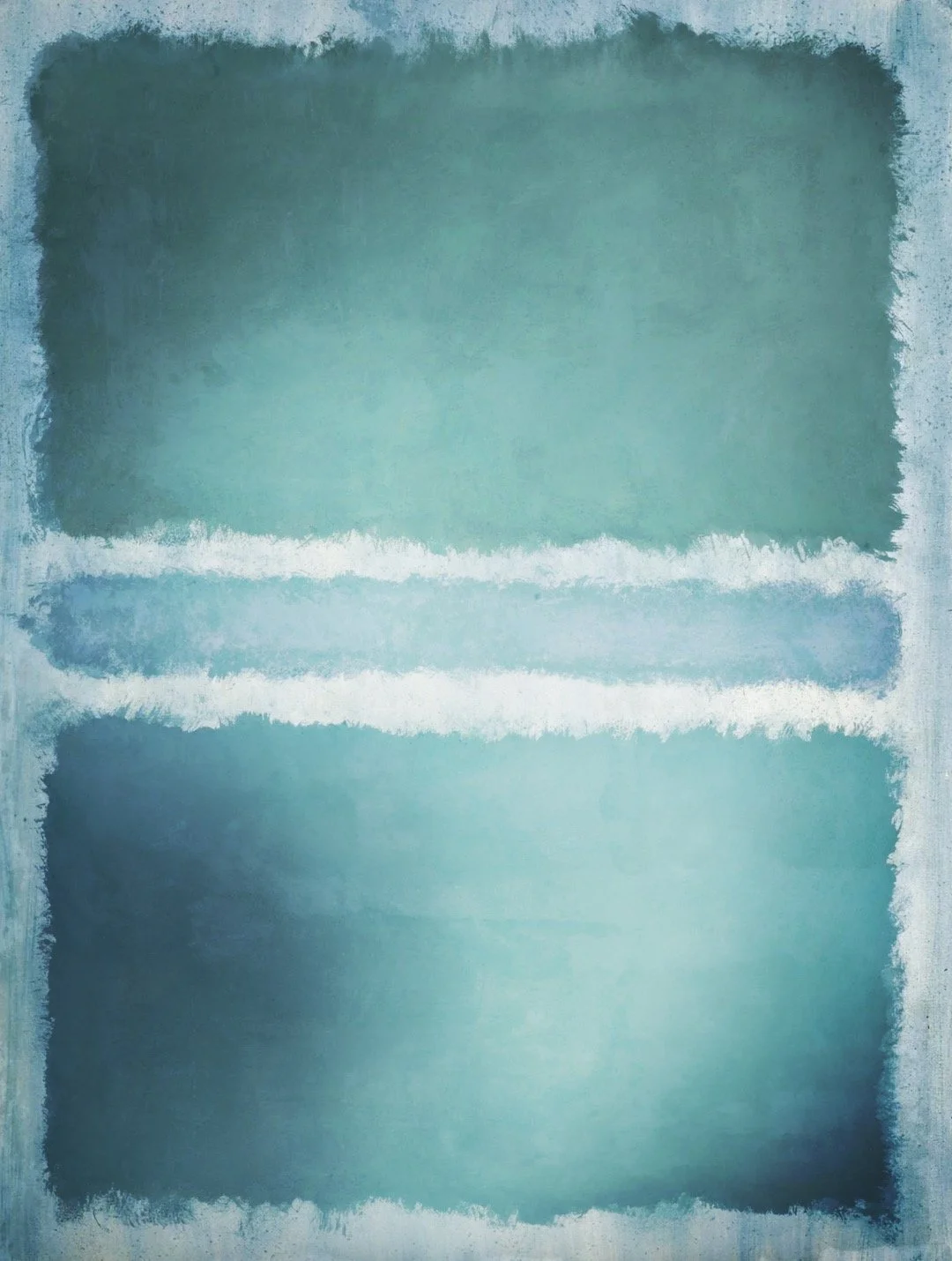Cover Image Rothko M, Blue Divided By Blue (1966)
Consider the voice behind an artwork. Contemplate what needs to be said and what can be left out in order to animate the work in one way or another.
Research several of the following artists to help you understand the narrative behind specific artworks: Simryn Gill, Christopher Wool, Lawrence Weiner, Ed Ruscha, Laure Provost, Corbin Shaw, Jade Montserrat, Christine Borland, Michael Borremans, Tacita Dean, Jeremy Deller and Katie Paterson.
Direct
Subjective
Representational
Abstract
Political
Environmental
Memory
Protagonist
Alarmist
Some approachable, some you just can’t unsee (Michael Borremans).
There’s an alignment of material + process + presentation
A tone.
I wouldn’t describe the content as exploited, more transformed to arrive at the right point of communication.
Wether biopic, succinct, epic, a clear progression of adding and subtracting parts. Borremans laborious oil paintings, or the simple and purposeful negation of elements in Prouvost’s video “we were out there”.
Interesting to me…..Corbin Shaw. Instantly reminding me of my Northern 1980’s / 90’s childhood….the innocence of adolescence, masking the deeper meaning of socio-political goings on.
I like mark making. So does Tacita Dean. Im probably more in her camp of creating ‘Voice’, rather than Lawrence Weiner or Katie Patterson, etc….But then how does ‘Voice’ factor into art that is not using the obvious text, video, speech mediums?
‘Voice’ in the case of abstract art, would be the way the artist communicates through a unique personal style. Open to interpretation, it’s not just demonstrating a sequence of events in the case of say, ‘Narration’.
In my head I thought who, in my opinion, is a dominant ‘Voice’ painter?…and Rothko came to mind, basically because his work is huge, yet very abstract, so a good candidate. I found this quote
“There’s no such thing as a good painting about nothing” (Rothko).
So the paintings are about something. Due to his personal experiences and being a part of a post war crowd in New York, he had quite a lot bubbling up inside him. He got very uppety when associated to colour or scale being the communicating factor in his work. Like large science projects to be analysed on the gallery walls.
For him it was the whole shebang, creating, thinking, putting himself into the art, removing himself from it so it was it’s own entity. And then handing it over to the viewer, like a spiritualistic offering.
Everyone seemed to like it and agree, part from maybe Reinhardt who seemed to tire with Rothko’s ‘Voice’ but that was probably in a bid to elevate himself.
Someone more current and with a much busier palette is Sarah Boyts Yoder. She makes abstract paintings, with candy colours and symbolistic elements that look recognisable but actually aren’t. And some look like pants, literally pants, not the slang pants when you think something is rubbish.
And she uses words too, so that’s much easier to clarify here that she has ‘Voice’ in her work.
Fig.1 Boyts Yoder S, Bun Squad (2014)
Terry Ekasala is probably my favourite painter with ‘Voice’ I liked her ‘Voice’ before I even knew what ‘Voice’ was. She has a concrete style (now) and wether she is painting a Munch like Scream / The Cry, or a semi abstract landscape that also looks like a circus tent, you know the paintings are speaking to you, or she is, (I don’t want to offend Rothko here by getting the notation wrong).
Fig.2 Ekasala T, Grief (2020)
The difference I feel between text / spoken style ‘Voice’, and abstract art ‘Voice’ is akin to someone stood in front of you clearly speaking, and someone behind double glazing mouthing the words….They could be saying “Turn the oven off before you go!”. Or you could hear, “Have a nice day!”. Minefield really.
List of Images
Cover Image Rothko, M. (1966) Blue Divided By Blue. [Acrylic on paper, mounted on canvas, photo edited with Hipstamatic] At:https://www.sothebys.com/en/auctions/ecatalogue/2007/contemporary-art-evening-auction-l07024/lot.45.html (Accessed 25.06.2025).
Fig.1 Boyts Yoder, S. (2014) Bun Squad. [Acrylic on paper] At:https://showandtellartanddesign.com/product/bun-squad/ (Accessed 25.06.2025).
Fig.2 Ekasala, T. (2020) Grief. [Acrylic on paper] At:https://www.terryekasala.com/work#/works-on-paper/ (Accessed 25.06.2025).
Bibliography
Museum Of Contemporary Art Australia. At:https://www.mca.com.au/collection/artists/simryn-gill/ (Accessed 25.06.2025).
Artnet. At:https://www.artnet.com/artists/christopher-wool/ (Accessed 25.06.2025).
Artnet. At:https://www.artnet.com/artists/ed-ruscha/ (Accessed 25.06.2025).
Laure Provost. At:https://www.laureprouvost.com (Accessed 25.06.2025).
Corbin Shaw. At:https://www.corbinshaw.com (Accessed 25.06.2025)>
Bosse & Baum. Jade Monserrat.At:https://www.bosseandbaum.com/artists/jade-montserrat/ (Accessed 25.06.2025).
Christine Borland. At:https://www.christineborland.com/artworks (Accessed 25.06.2025)>
David Zwirner. Micheal Borremans. At:https://www.davidzwirner.com/artists/michael-borremans (Accessed 25.06.2025).
You Tube – The Menil Collection. (2024) Tacita Dean: Blind Folly. At:https://www.google.com/search?q=tacita+dean+blind+folly+youtube&client=safari&sca_esv=d9e56f0127f62959&rls=en&ei=qDZmaK7qCca5i-gPkvngaQ&ved=0ahUKEwiu3v27mqCOAxXG3AIHHZI8OA0Q4dUDCBA&uact=5&oq=tacita+dean+blind+folly+youtube&gs_lp=Egxnd3Mtd2l6LXNlcnAiH3RhY2l0YSBkZWFuIGJsaW5kIGZvbGx5IHlvdXR1YmUyBRAAGO8FMgUQABjvBTIFEAAY7wUyCBAAGIAEGKIEMgUQABjvBUi0HFDNA1jMGnAAeAKQAQCYAYsBoAGFCqoBAzMuObgBA8gBAPgBAZgCDKAC8QnCAgQQABhHwgIGEAAYDRgewgIIEAAYogQYiQXCAgoQIRigARjDBBgKwgIIECEYoAEYwwTCAgQQIRgKmAMA4gMFEgExIECIBgGQBgSSBwQyLjEwoAeyPrIHBDEuMTC4B-cJwgcFMi05LjPIB1E&sclient=gws-wiz-serp#fpstate=ive&vld=cid:6a082a07,vid:xSIGJUVeJ4A,st:0 (Accessed 25.06.2025).
Artsy. At:https://www.artsy.net/artist/jeremy-deller (Accessed 25.06.2025).
Katie Paterson. At:https://katiepaterson.org/artwork/evergreen/ (Accessed 25.06.2025).


